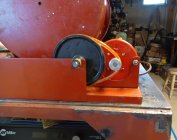The urethane belting arrived today so as promised, here's my writeup of making a belt.
I didn't have an official belt to work with to know what size to make it, so I wrapped the belt around the pulleys and let that be my guide. Initially I allowed an extra 1/4" for the squeeze out that would occur with the hot joining. This turned out to be too much. The belt is stiff so it isn't tight around the small pulley when you do this and that outward bowing of the belt is adding the extra slack you'll need for the heating. In the end the belt was about 12.5" in length. I cut the belt to length with wire cutters. You could probably do it with a knife.
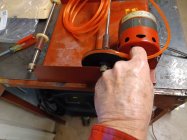
Below is the setup I used to heat the ends of the belt. The torch was applied to the end of the metal, and the two belt ends applied to either side of the metal once it was hot. Then over to some wooden blocks to use as a guide to get the ends alined. I tried to do this once by freehand, but I didn't get it lined up as well as I wanted, so I cut some small wood blocks that I could lay the belt on and slide the ends together.
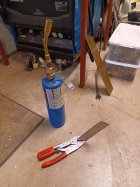
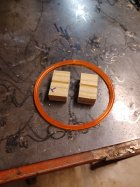
If I were doing this again, I'd place the belt ends near the edge of the hot metal and slide them off the plate together so that they touched immediately. It doesn't stay "liquidy" very long once it's off the plate, BUT I learned that you have to hold the ends together for quite awhile until the urethane is cooled enough not to pull apart. Once it's cooled, try to pull it apart. If it pulls apart, heat it again and repeat. Three guesses how I know about that.
There is some flashing / squeeze out to be removed from the join. Big nail clippers worked well to remove this.
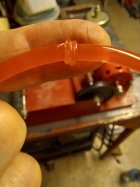
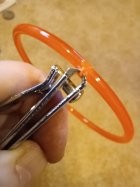
Then it was time to mount it on the tumbler. The first belt looked like it was doing great - and then the join broke!!! In frustration I went back and stuck the belt ends directly into the flame and they were beginning to droop and flame, then pushed them together. I didn't get as good of a join, but it's certainly holding. I've been running the tumbler for about an hour now to be sure it won't break again and will let it run for a few hours. to be sure. I've stressed it by putting drag on the drum to act like it was overweighted. The belt grabs well and isn't slipping or stretching like the other substitute belts I'd tried.
If I had known about the set of 3 belts on eBay I probably wouldn't have made my own. My belt seems to be working, but buying a proper size O ring would be a lot more convenient.
At an hour, I pulled the belt off to look at the join. It's pulling apart on the outer edge, so it looks like I'll be rejoining this. I'm wondering if my plate needs to be hotter to get the urethane to melt / liquify more. This method works, but there's some technique involved.










